Danzig |
|
|
|
| Übersicht – Contents: | |
Danzig |
|
|
|
| Übersicht – Contents: | |
Flaggen – Flags: |
|
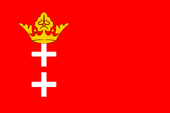 |
Staats- und Handelsflagge – state and merchant flag, Seitenverhältnis – ratio = 2:3 |
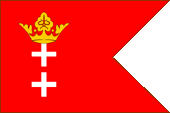 |
Dienstflagge
– official flag, Seitenverhältnis – ratio = 2:3 |
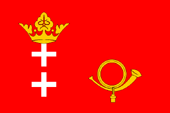 |
Postflagge
– postal service flag, Seitenverhältnis – ratio = 2:3 |
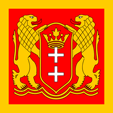 |
Flagge des Senats
– flag of the senate, Seitenverhältnis – ratio = 1:1 |
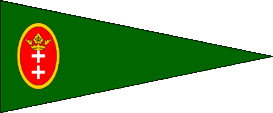 |
Polizeistander – police pennant |
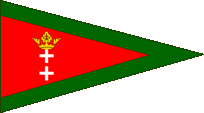 |
Zollstander – customs pennant |
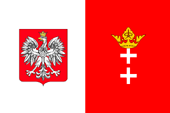 |
Flagge des Ausschusses für den Hafen und die Wasserwege
– flag of the commission for the port and the seaways, Seitenverhältnis – ratio = 2:3 |
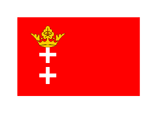 |
Lotsen(ruf)flagge
– pilot jack, Seitenverhältnis – ratio = 13:18 |
historische Flaggen – historical Flags: |
|
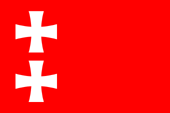 |
Mitte
des 14.Jhd. bis 1457 middle of 14th cent. to 1457, Flagge der Stadt Danzig – flag of Danzig Town, Quelle/Source: Wikipedia (DE) |
 |
1457–1920, seit/since 1939, Flagge der Stadt Danzig – flag of Danzig Town, Seitenverhältnis – ratio = 2:3, Quelle/Source: Wikipedia (DE) |
Bedeutung/Ursprung der Flagge – Meaning/Origin of the Flag: |
|
| Die Flagge Danzigs leitet sich aus dem Stadtwappen ab. Sie ist als Stadtflagge noch heute in Gebrauch. Wann das Flaggen- und Wappenbild von Danzig mit seinen zwei Kreuzen entstanden ist, ist nicht bekannt. Es geht aber auf den Deutschen Orden zurück und zeigt zwei untereinander angeordnete weiße Ordenskreuze auf rotem Grund. Das Motiv ist entweder 1309 aufgekommen, als der Deutsche Orden die Wallburg an der Mottlau bezog, oder im Jahr 1340, als der Deutsche Orden seinen Hauptsitz in die Marienburg verlegte. Die Farben Rot und Weiß haben ihre Wurzeln in den Farben des Hanse Städtebundes, dessen Mitglied Danzig im Jahre 1361 wurde. Am 15.05.1457 wurde Danzig vom Polnischen König Kasimir mit umfangreichen Sonderrechten ausgestattet (Privilegia Casimirana). Ab diesem Datum wurde das Flaggenmotiv (auch im Wappen) um die polnische Königskrone ergänzt. | The flag
of Danzig infers the coat of arms of the city. It is in use as flag of the
town until today's. When the motive of the flag or the coat of arms of
Danzig with its two crosses arised first is not known. It has its roots in
the Order of the Teutonic Knights and shows two one below the other arranged
white order's crosses on red ground. The motive arised either 1309, as the
Order of the Teutonic Knights moved into the Wallburg at Mottlau River, or
in the year 1340, as the Order of the Teutonic Knights moved its seat to
Marienburg. The colours red and white have their roots in the colours of the
Hanse Town's Conederation and Danzig became a member in the year 1361. On
15th of May in 1457 Danzig became awarded extensive privileges by the Polish
King Casimir (Privilegia Casimirana). Since that point in time the motive of
the flag (and also of the coat of arms) was added by the Polish royal crown. |
| Quelle/Source: Historische Fahnen, Volker Preuß | |
Wappen – Coat of Arms: |
|
 |
Wappen von Danzig – coat of arms of Danzig, Quelle/Source: Wikipedia (DE) |
Bedeutung/Ursprung des Wappens – Meaning/Origin of the Coat of Arms: |
|
| Das Wappen der Stadt Danzig (die hier gezeigte Form entspricht der Ausführung auf der Flagge des Senats der Freien Stadt Danzig) zeigt, wie die Flagge, zwei weiße Ordenskreuze unter einer Krone auf rotem Grund. (siehe "Flagge"). | The coat
of arms of the city of Danzig (the here shown shape corresponds to the
depiction on the flag of the Senate of the Free City of Danzig), shows like
the flag, two white crosses under a crown on red ground. (look "flag"). |
Landkarte – Map: |
Lage im heutigen Polen – Position in today's Poland: |
Zahlen und Fakten – Numbers and Facts: |
|
|
|
|
|
|
|
|
|
|
|
|
|
|
|
|
|
|
|
|
|
Geschichte: |
|
997 · erste Erwähnung Danzigs 1263 · lübisches Stadtrecht 1309–1454 · zum Deutschen Orden 1361 · Mitglied der Hanse seit 1454 · unter dem Schutz Polens 1457 · Privilegia Casimirana 1793 · Inbesitznahme durch Preußen 1807 · Freie Stadt Danzig 1814 · preußische Inbesitznahme 10.01.1920 · vom Deutschen Reich abgetrennt und als Freistaat dem Völkerbund unterstellt 01.09.1939 · Wiedereingliederung in das Deutsche Reich 1945 · polnischer Verwaltung unterstellt, Vertreibung der verbliebenen deutschen Bevölkerung |
History: |
|
997 · first mentions of Danzig 1263 · town law of Luebeck 1309–1454 · to the Teutonic Order 1361 · member of the Hanse since 1454 · under protection of Poland 1457 · Privilegia Casimirana 1793 · appropriation by Prussia 1807 · Freetown of Danzig 1814 · Prussian appropriation 10th of January 1920 · separated from the German Empire and the League of Nations subordinated as a free state 1st of September 1939 · re-incorporation into the German Empire 1945 · Polish administration subordinated, expulsion of the remained German population |
| Quelle/Source: Atlas zur Geschichte, Wikipedia (D) |
Ursprung des Landesnamens – Origin of the Country's Name: |
|
| Der Name Danzig geht über das slawische Wort "Gdansk" auf das gotische Wort "gutisk" zurück. Es bedeutet "gotisch", und zeigt dass die Region einst zum Herrschaftsgebiet der Goten gehörte. Auf Lateinisch heißt die Stadt "Gedanum". | The name
"Danzig" has its roots in the Slavic word "Gdansk" and further back in the
Gothic word "gutisk", and shows that the region belonged to the dominion of
the Goths. In Latin is the city called "Gedanum". |
| Quelle/Source: Handbuch der geographischen Namen, RetroLib Retrobibliothek | |
|
Mit freundlicher Untersützung von: Kindly supported by: |
Christian Kucharski (D) |